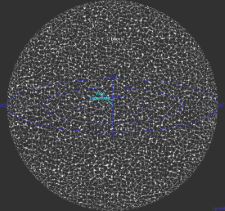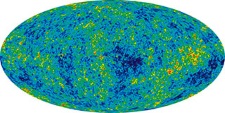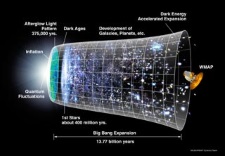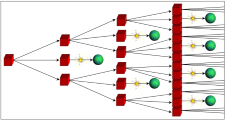In his essay “Circles,” Ralph Waldo Emerson writes:
St. Augustine described the nature of God as a circle whose centre was everywhere, and its circumference nowhere.
The center of town is toward Public Square. The center of the Earth is always down. The center of our solar system moves from east to west every waking day. The center of our galaxy is toward its black hole in Sagittarius. But, the center of our universe is … everywhere!
The scientific method runs from observing the physical world, to making a theory that describes and predicts its behavior, to testing the prediction. The best theory accounts for the most behavior in the simplest terms. Albert Einstein brought forth the theory of general relativity, and defined it with ten mathematical equations. But, he found that he could simplify to one equation with the assumption that, in the long view, the universe is the same everywhere — without much variation, without direction, without a single center. That assumption is called the cosmological principal.
Further observation has borne out the cosmological principal. Looking up in any direction, we find the same types of galaxies, which are bunched into galactic clusters, which are strung into superclusters. As we look further out, we look further back in time. To the Sun we look back eight minutes — the time it takes light to travel from there to Earth. To the center of our galaxy, we look back 26,000 years; to the next nearest major galaxy (Andromeda), 2.3 million years; to the nearest large galactic cluster (Virgo), 52 million years; to the next nearest large supercluster (Centaurus) 140 million years. And to the furthest point we can see, we look back 13.7 billion years — just 380,000 years after the Hot Big Bang. That furthest point is at the Cosmic Microwave Background (CMB). We find the CMB in every direction up. And its heat map is without much variation — in fact, it is 99.999% uniform. From any other galaxy in the universe, an observer that looked up would see virtually the same picture that we do.
What lies beyond and back in time before the CMB we cannot directly see, because the universe was then opaque. But the CMB, by its very presence, and the intensities of energy over its frequency spectrum, fulfills predictions of the Big Bang Theory — the current standard model of the universe. So we know that there was a Hot Big Bang — when the universe was extremely hot, dense, and rapidly expanding. And by its highly-uniform heat map, the tiny temperature variations across the heat map, and the imprint of gravity waves in the heat map’s variations, the CMB fulfills predictions of Cosmic Inflation Theory. So, though we await confirmation of the gravity waves finding, which was just announced this year, it is now likely that our universe’s region of space inflated — stretched from sub-atomic size to macro size in a split instant. As inflation ended, much of its expansion energy may have changed into particles, changing the universe from extremely cold and empty with accelerating expansion to extremely hot and dense with decelerating expansion, and feeding into the Hot Big Bang.
What lies beyond and back in time before the onset of cosmic inflation? We don’t know, but by most variants of Cosmic Inflation Theory, cosmic inflation goes on forever, screamingly stretching space. And if cosmic inflation has fed into one hot big bang and popped-out one universe, then it would also pop-out many, or infinitely, more such universes. So Cosmic Inflation Theory, which has many correct (and no known incorrect) predictions, also predicts parallel universes! And the march of science goes on: As one wonder is described, proven and woven into the tapestry of human knowledge, another arises — it too wanting description and proof. Emerson writes:
Our life is an apprenticeship to the truth, that around every circle another can be drawn; that there is no end in nature, but every end is a beginning; that there is always another dawn risen on mid-noon, and under every deep a lower deep opens.
Terms
Big Bang: Some take “Big Bang” to mean the Hot Big Bang, some the onset of Cosmic Inflation, and some Time 0 — the very beginning of everything. The Hot Big Bang has heat and rapid expansion. The onset of Cosmic Inflation is cold, but has screamingly rapid expansion. But Time 0 is unknown. Rather than a big bang, it may be a wee whisper.
Universe: Brian Greene writes: “There was a time when “universe” meant “all there is. … Sometimes “universe” still connotes absolutely everything. Sometimes it refers only to those parts of everything that someone such as you or I could, in principle have access to. Sometimes it’s applied to separate realms, ones that are partly or fully, temporarily or permanently, inaccessible to us; in this sense, the word relegates our universe to membership in a large, perhaps infinitely large, collection.”
Sources
Image: Map of the visible universe centered on our galactic supercluster (Virgo). – atlasoftheuniverse.com
Circles “Circles” by Ralph Waldo Emerson; from “Essays: First Series” (1841)
black hole in Sagittarius “Towards the Center of the Milky Way” by Quinn Hungeski, The Paragraph, 2006-03-21
scientific method “Scientific Method” – Wikipedia
simplify “The Hidden Reality” by Brian Greene; 2011; P. 25
cosmological principal “The Cosmological Principal” – The Universe Adventure; UC Berkely
Image: Heat Map of the CMB – WMAP probe, NASA
find The Visible Universe – atlasoftheuniverse.com
To the Sun
“Reference: How Fast Does Light Travel? | The Speed of Light” by Nola Taylor Redd, SPACE.com; May 22, 2012
To the center of our galaxy “The Milky Way Galaxy” – NASA
to the next nearest major galaxy “The Local Group” – NASA
to the nearest large galactic cluster “A List of Nearby Galaxy Groups” – atlasoftheuniverse.com
to the next nearest large supercluster “The Neighboring Superclusters” – atlasoftheuniverse.com
to the furthest point “Hot Big Bang” – Matt Strassler; March 15, 2014
Cosmic Microwave Background “The Universe According to Planck (The Satellite)” – Matt Strassler; March 21, 2013
99.999% uniform “Which Parts of the Big Bang Theory are Reliable, and Why?” – Matt Strassler; March 26, 2014
Image: Timeline of the Universe – WMAP, NASA
opaque “Tests of Big Bang: The CMB” – NASA
intensities of energy “Which Parts of the Big Bang Theory are Reliable, and Why?” – Matt Strassler; March 26, 2014
Big Bang Theory “Big Bang Cosmology” – NASA
Hot Big Bang “Hot Big Bang” – Matt Strassler; March 15, 2014
highly-uniform heat map “Which Parts of the Big Bang Theory are Reliable, and Why?” – Matt Strassler; March 26, 2014
the tiny temperature variations ” Cosmic Background Radiation” – University of Oregon
imprint of gravity waves ”
Cosmic Inflation: How It Gave the Universe the Ultimate Kickstart (Infographic)” By Karl Tate, Infographics Artist; Space.com; March 17, 2014
Cosmic Inflation Theory “Inflation” by Matt Strassler; March 15, 2014
await confirmation “BICEP2: New Evidence Of Cosmic Inflation!” – Matt Strassler; March 17, 2014
announced this year “Cosmic inflation: ‘Spectacular’ discovery hailed” By Jonathan Amos, Science correspondent, BBC News; 17 March 2014
Image: Cosmic Inflation popping-out universes “Our Mathematical Universe” by Max Tegmark; Ch. 5; PDF
don’t know “Before Inflation” by Matt Strassler; March 15, 2014
most variants “Space Ripples Reveal Big Bang’s Smoking Gun” By DENNIS OVERBYE; The New York Times; MARCH 17, 2014
pop-out many “Our Mathematical Universe” by Max Tegmark; Ch. 5; 2014; PDF
no known incorrect “Inflation” by Matt Strassler; March 15, 2014
predicts parallel universes “Our Mathematical Universe” by Max Tegmark; 2014
Big Bang “Inflation” by Matt Strassler; March 15, 2014
Brian Greene writes “The Hidden Reality” by Brian Greene; 2011; P. 12
* * *
By Quinn Hungeski, TheParagraph.com, Copyright (CC BY-ND) 2014





Parallel universes. Quantum leaps between times – a la “Back to the Future.” Thanks for the lucid description of why these concepts work.